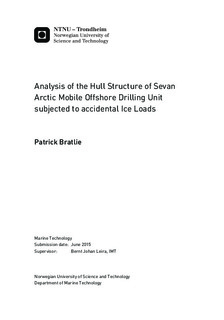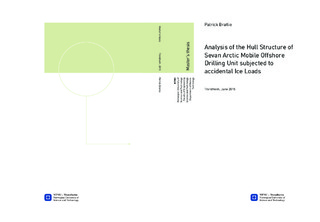| dc.description.abstract | Due to an increasing energy demand in the world, the interest of the Arctic region related to offshore oil and gas exploration is increasing. The demand of structures capable of operating in the harsh Arctic environment is therefore expected to increase. Such structures need to overcome challenges like dealing with extremely low temperature and ice loads. The Sevan Arctic Mobile Offshore Drilling Unit (Sevan Arctic MODU) is an Arctic drilling concept developed by Sevan Marine. The main scope of the thesis has been to investigate how this structure are capable of dealing with large and unexpected ice loading.
Ice is a complicated material. When compressed zones of high pressure forces may develop, accompanied by effects like spalling, splitting recrystallization. Because of the complicated mechanical behaviour, the forces exerted from ice onto a structure are often simulated with a pressure-area relationship. However, using such a relationship in a collision analysis proves to be insufficient since it does not take into account local effects in a good way.
Abaqus has been used to model a part of the Sevan Arctic MODU. The model considered is a part of the platforms outer wall. The structural models have been used in non-linear finite elements analyses to investigate relevant loading conditions. The models have been used assess two topics concerning a collision between a small iceberg and a floating structure. The first topic was to see how the drilling unit reacts to high concentrated pressure loads which may be present in a collision. It was found that the structure is able to resist high forces without experience critical damage. It was also found that the impact location is less important in an iceberg collision than when the structure is subjected to level ice and smaller ice features. This is because the structure is designed with a sloping hull form in the ice draft, reducing the forces from incoming level ice by forcing the ice to fail in bending.
The second topic was to simulate a collision between the platform and an iceberg. The forces from the iceberg acting on the structure were calculated by considering the energy in the collision. In these calculations it was assumed that all of the kinetic energy in the collision was dissipated as crushing energy in the iceberg. The results from these energy considerations were implemented in Abaqus in terms of a pressure-area dependent load. | |

